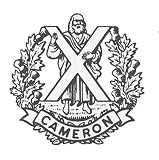This page is based on this
Wikipedia article Text is available under the
CC BY-SA 4.0 license; additional terms may apply.
Images, videos and audio are available under their respective licenses.

The Queen's Own Cameron Highlanders or 79th Regiment of Foot was a line infantry regiment of the British Army, raised in 1793. It amalgamated with the Seaforth Highlanders to form the Queen's Own Highlanders in 1961.

A Scottish regiment is any regiment that at some time in its history has or had a name that referred to Scotland or some part, thereof, and adopted items of Scottish dress. These regiments were and are usually a product of the British Empire, either directly serving the United Kingdom, serving as colonial troops, or later as part of Commonwealth country military establishments. Their "Scottishness" is no longer necessarily due to recruitment in Scotland nor any proportion of members of Scottish ancestry. Traditionally, Scottish regiments cultivate a reputation of exceptional fierceness in combat and are often given romantic portrayals in popular media. Within Scotland, itself, regiments of the Scottish Lowlands didn't adopt as distinctively "Scottish" uniforms until the late Victorian Era and even then the kilt, that most distinctive aspect of the Highland soldier, was not adopted wholesale.
The 77th Regiment of Foot was a Highland Scots Regiment raised in 1757. The 77th Regiment was one of the first three Highland Regiments to fight in North America. During the Seven Years' War, the regiment lost 110 soldiers and 259 were wounded.
The 78th Regiment, (Highland) Regiment of Foot also known as the 78th Fraser Highlanders was a British infantry regiment of the line raised in Scotland in 1757, to fight in the Seven Years' War. The 78th Regiment was one of the first three Highland Regiments to fight in North America.

The Glasgow Highlanders was a former infantry regiment of the British Army, part of the Territorial Force, later renamed the Territorial Army. The regiment eventually became a Volunteer Battalion of the Highland Light Infantry in 1881. The regiment saw active service in both World War I and World War II. In 1959 the Highland Light Infantry was amalgamated with the Royal Scots Fusiliers to form the Royal Highland Fusiliers. The Glasgow Highlanders was later amalgamated into the 52nd Lowland Volunteers in 1967.

The 73rd Regiment of Foot was an infantry regiment of the British Army, raised in 1780. Under the Childers Reforms it amalgamated with the 42nd Regiment of Foot to form the Black Watch in 1881.

The Royal Canadian Infantry Corps is the infantry corps of the Canadian Army and includes regular and reserve force regiments.

The 42nd Regiment of Foot was a Scottish infantry regiment in the British Army also known as the Black Watch. Originally titled Crawford's Highlanders or the Highland Regiment and numbered 43rd in the line, in 1748, on the disbanding of Oglethorpe's Regiment of Foot, they were renumbered 42nd and in 1751 formally titled the 42nd (Highland) Regiment of Foot. The 42nd Regiment was one of the first three Highland Regiments to fight in North America. In 1881 the regiment was named The Royal Highland Regiment , being officially redesignated The Black Watch in 1931. In 2006 the Black Watch became part of the Royal Regiment of Scotland.

The 72nd Highlanders was a British Army Highland Infantry Regiment of the Line, raised in 1778. Under the Childers Reforms it amalgamated with the 78th (Highlanders) Regiment to form the 1st Battalion of the Seaforth Highlanders in 1881.
The 91st Regiment of Foot was a Line Regiment of the British Army, raised in 1794. Under the Childers Reforms it amalgamated with the 93rd Regiment of Foot to form the Argyll and Sutherland Highlanders in 1881.
The 87th Regiment of Foot was a Scottish infantry regiment in the British Army, formed in 1759 and disbanded in 1763.

The Assaye battle honour was awarded by the Governor General of British India to all East India Company battalions and British Army regiments that took part of the Battle of Assaye. The battle occurred on 23 September 1803, near the village of Assaye in western India where a small force under the command of Major General Arthur Wellesley defeated a 50,000 strong army of the Maratha Confederacy. The British and native troops were awarded the battle honour Assaye with the device of Elephant vide General Order of Governor General dated 30 October 1803. The British regiments and Madras battalions involved were also presented with an honorary colour to mark their achievement. The Madras Battalions celebrated the victory for over a century till their disbandment in the 1920s.
Four regiments of the British Army have been numbered the 73rd Regiment of Foot:
Four regiments of the British Army have been numbered the 74th Regiment of Foot:
Five regiments of the British Army have been numbered the 72nd Regiment of Foot:
The 89th (Highland) Regiment of Foot or Morris's Highlanders was an infantry regiment in the British Army from 1759 to 1765.








